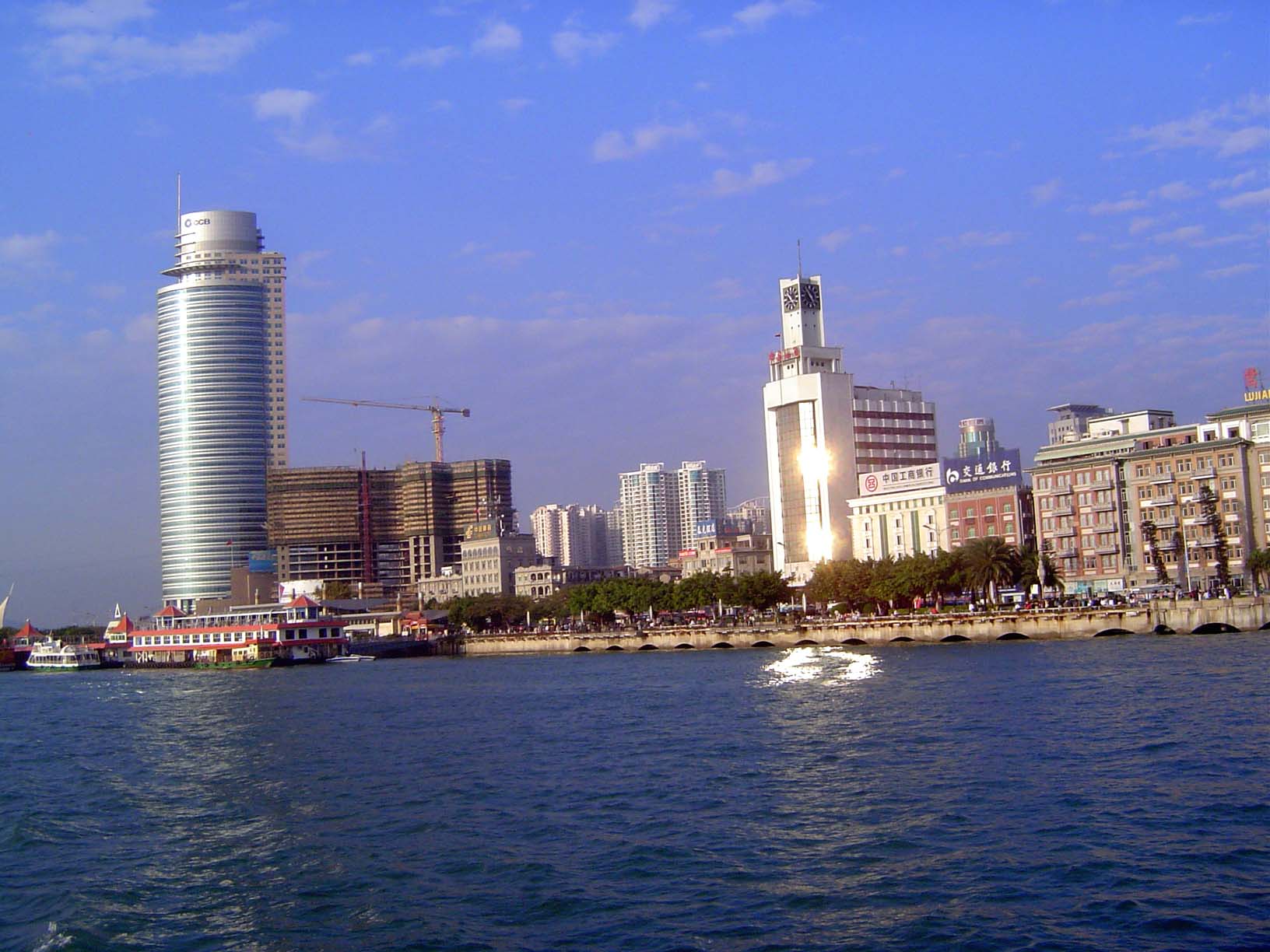
Gulangyu is a tiny island off the coast of Xiamen or Amoy, as it used to be called. Back then, Gulangyu was the European settlement, isolated from the Chinese across the bay. Now Gulangyu has become a major tourist magnet, perhaps because many of the grandest villas were built after World War I by overseas Chinese, or perhaps because Western styles are associated with wealth in contemporary China. Or maybe it's just because Gulangyu is very quiet, with a near-total prohibition on motor vehicles.
We're looking backwards on the ferry from Xiamen.
A resident, Philip Pitcher, wrote in 1909 that "Kolongsu... lies within easy rowing distance of Amoy city. It has consequently been the residential quarter of the merchantile [sic] and missionary community in this part of the Far East. For situation and natural attractions, with its beautiful harbor and grand hills around it, it is unsurpassed anywhere along this entire coast. From two hundred to two hundred and fifty foreigners reside here in very comfortable homes; and since the inauguration of the Municipal Council's regulations these homes have been placed under vastly improved conditions...."
Pitcher gives a little background, too, explaining that "when the British troops were stationed here on this island in 1841 they were stricken down by the hundred with fever. Hence the place had no attractions for the missionaries and merchants who came in the early forties. But about 1860 they began to move over, having discovered their mistake, and have lived here very comfortably ever since in well built houses, situated for the most part on high elevations, with sea views on all sides. (Philip Wilson Pitcher, In and About Amoy, 1909, pp. 117-119.)
A few years earlier, a missionary had commented on the awkwardness of this separation. John Macgowan wrote that "foreigners live on Kulangsu, whilst the business houses are all across the harbour in Amoy, the business men crossing over to them in the morning and returning in the afternoon. The English consulate, which used in former years to be placed in close proximity to the hongs, has, for some inscrutable reason best known to the Foreign Office, been built on Kulangsu, to the great inconvenience of the merchants, who find themselves very much troubled by having to cross over the water every time they have any business with the Consulate." (Pictures of Southern China, 1897, p. 148)
Approaching Gulangyu. In 1903 the island became an International Foreign Settlement, with control shared by Great Britain, Germany, Holland, Spain, and Japan. A municipal council was set up, and a police force with 14 Sikh constables.
The harbor.
Sorry, but you'll just have to run the gauntlet.
There's a scattering of antiques, perhaps vacuumed up from around the island.
Guesthouse owners have tried various ways to draw visitors.
There's a real community here, too, and has been for a long time; as far back as the census of 1909, Gulangyu had between 7,000 and 8,000 Chinese residents, many of them presumably working for the island's wealthy families.
Not all of the island, in other words, is for the villas of the rich or for wandering visitors.
In some cases, villas have been broken up into apartments.
Around that Chinese core, which is close to the dock at the left, about a thousand villas survive. This model, in the local museum, gives a sense of their number and density.
We can begin with this most unusual building, perched atop a cliff. It's been there 1876, however, so it's presumably safe. What was it?
Here's the building up top. The plaque on the wall says that the building housed HSBC staff.
This was their view, or at least the scope of it. Macgowan, the missionary, wasn't too impressed by the actual view in 1897. He wrote, "On the opposite side of the bay lies the island of Amoy. It is rugged and desolate-looking, and gives one the impression that Nature has abandoned it in despair as a hopeless place for the exercise of her genius" (p. 142).
Still, many residents chose hilltops, or at least hill slopes. Here's one of the most famous of the villas, the so-called Octagon House.
Here it is again.
Designed by a Dutch-American who happened to be the president of the island's hospital, the Octagon House was built in 1907 for Lin Heshou.
As the most visually prominent building on the island, at least from Xiamen, it's being carefully restored.
Tea for the workmen.
Nearby is this grim building, redolent of the American South. It was formerly the U.S. consulate.
This is the Chuncao Villa of 1933. It's on a hilltop and has a fine view. Luckily, we can take a peek inside.
Doorway.
Wainscoting.
Almirah.
Here's a place in vastly better shape, though we can't go in. It's from 1920 and was the villa of Huang Rongyuan, built by a father and son about 1920. They had made a fortune in the Philippines.
In nearly solitary grandeur, this house was built in 1926 by Li Qingquan, also a businessman in the Philippines.
Here's the slightly later villa built by Huang Zhongxun, who had made his fortune in Annam.
There are several Christian churches on the island. Here's Trinity Church, begun about 1930.
Here's the slightly older Catholic Church, from 1917.
The ferries run late. Xiamen, by the way, is the second city of Fujian. (Fuzhou is first.) It was designated a Special Economic Zone in 1980, and despite historically poor rail and road conditions (Mao feared invasion from nearby Taiwan), the city is now thriving. Dell has a plant here for the Chinese market. Phillips is here. Black and Decker. Eastman Kodak makes color films and paper and in 2007 operated the world's biggest disposable camera plant. The airport is crucial, and the city has nonstop flights to Tokyo, Bangkok, Seoul, Osaka, Manila, and Singapore. It also has perhaps Asia's biggest aircraft maintenance center, run by Taikoo Aircraft Engineering, whose owners include Boeing, Cathay Pacific, and Japan Airlines.